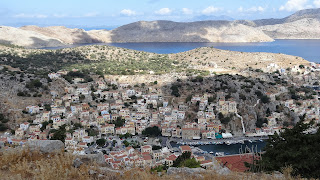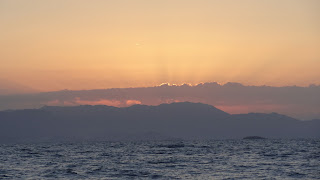Simi is about 20 nautical miles due east of Nisiros, right in the Gulf of Doris in Turkey. Lots of cruisers had recommended a visit: Simi is famous for its crystal clear waters and the beauty of the main town and its harbour. The harbour is also a bit notorious for overcrowding with tripper boats, ferries and charter fleets. We’ve become reasonably adept at Med mooring – dropping the anchor well out in front of your berth and backing in – but we’ve had a few bad experiences attempting it in high winds, and also had other boats pull up our anchor while retrieving theirs, so, if there’s a good alternative we tend to take it. On Simi, the alternative is Ormos Panormitis, a sheltered bay on the south west of the island. We anchored out in the quiet bay, which has room for quite a fleet, and is overlooked by a monastery dedicated to St George. The water would probably be clear if it wasn’t for the ferries churning it all up a couple of times a day – it looked like turquoise milk. We had a pleasant meal at the lone taverna, along with most of the other boat people in the bay.
A bus leaves Panormitis each morning at 7.20, so we were outside the store bright and early next day for what turned out to be a spectacular trip through the island’s winding mountain roads – more like a plane flight than a bus ride. The seat next to the driver was obviously a coveted spot, and as soon as one local alighted, someone else would move up to ride shotgun. This person’s role seemed to be to distract the driver with loud conversation and dramatic gesticulation, particularly while negotiating hairpin bends.
Arriving safely in Simi town we sat in a café for a while and watched the place come to life, with shopkeepers opening up, fishermen docking and selling their catch, tour groups arriving and the waterfront cafes and restaurants filling to capacity. It really is an attractive town, with its colourful Venetian era houses and cobbled streets winding their way up the mountain. We managed the challenging walk up to the top, in pursuit of a geocache at the inevitable mountaintop church, but it was worth it for the stunning views of the harbour and the rugged coast of Turkey beyond.
Next day we set sail early for the island of Rhodes, the largest of the Dodecanese and the most popular tourist destination in Greece. A steep rugged island, it has few good anchorages and we had been warned off going into the main harbour with stories of dense ferry traffic, anchor wars and overcharging. Fortunately we also had a few good tips for anchorages just east of the harbour, and it was in one of these, Limin Arkandia, that we settled for a couple of days. Only one little old sailboat was occupying the bay, and we were a little anxious that everyone else might know something that we didn’t. Good shelter from the wind, good holding, very close to one of the gates of the Old City … admittedly it wasn’t the most attractive of areas, with a lot of run-down buildings ashore, and some big ferries did moor further out, but it suited us fine.
Just a quick dinghy ride and a short stroll and we were at the Akandia Gate, the easternmost entrance to Rhodes’ old walled city. Within the city, the Knights’ Quarter was the headquarters of the Knights of St John in medieval times, and quite a lot remains of the old fortifications.
The Hora is the old Turkish part of the city and is now full of colourful shops and restaurants. Terry discovered the wide angle lens he has been looking for in a tiny camera shop, and has been making good use of it since, while I bought a few gifts and a very nautical-looking cotton knit jacket. The harbour is busy and quite spectacular, with its antelope statues at the entrance – though of course sailing between the legs of the famous Colossus (did it bestride the harbour or not – the debate continues) would have been a wonder indeed.
There is a good museum within the old town, and we discovered a bar called “Mr Troll” where Terry was able to enjoy one of his favourite beers – more of which in the next instalment of his Beer Tour of the World.
The Hora is the old Turkish part of the city and is now full of colourful shops and restaurants. Terry discovered the wide angle lens he has been looking for in a tiny camera shop, and has been making good use of it since, while I bought a few gifts and a very nautical-looking cotton knit jacket. The harbour is busy and quite spectacular, with its antelope statues at the entrance – though of course sailing between the legs of the famous Colossus (did it bestride the harbour or not – the debate continues) would have been a wonder indeed.
There is a good museum within the old town, and we discovered a bar called “Mr Troll” where Terry was able to enjoy one of his favourite beers – more of which in the next instalment of his Beer Tour of the World.
There is a lot more to see on this remarkable island, but we will have to save it for the return journey as we have nearly run out of legal days in Greece. The Shengen Agreement, which limits non-EU visitors to 90 days, must be having a negative impact on tourism in the Greek islands. It was obviously introduced to combat illegal immigration, but as is so often the case, there are unintended consequences. There are 25 yachts from non-Shengen countries wintering in Finike with us, and many more in other Turkish marinas. I’m sure that a lot of them would have stayed in Greece if they could, spending money and supporting the small businesses – restaurants, bars, market stalls, chandlers, mechanics, laundries, canvas repairs, car hire etc etc – that are currently battling to survive.
So, the last leg in Greece, Rhodes to Kastellorizo. This was a pleasant overnight passage, which we managed under sail until the early hours of the morning when the wind died. Even then, a following current helped to push us along and we were scooting along the mountainous Turkish coast as the sun rose. Kastellorizo, also known as Megisti, is the easternmost major island of Greece. (The tiny island of Ro is slightly closer – famous for Despina, the ‘Lady of Ro’ who lived alone on the island until she died at 94, and proudly raised the Greek flag every day throughout the Italian occupation). Kastellorizo used to sustain a population of around 20,000, now down to about 200. Its stories are the usual Mediterranean tragedies of natural disaster, war and occupation. The island was attacked by both sides during World War II, with the bombing of a fuel depot taking out much of the town.
Many evacuees had nothing to return to, and settled overseas. A great many of Western Australia’s Greek families hail from this tiny island, and Aussie accents are as common as Greek ones, with many ‘Kassies’ returning here for holidays, family reunions or to claim and renovate the old family home.
Many evacuees had nothing to return to, and settled overseas. A great many of Western Australia’s Greek families hail from this tiny island, and Aussie accents are as common as Greek ones, with many ‘Kassies’ returning here for holidays, family reunions or to claim and renovate the old family home.
We arrived at just the right time – about 0930 – before the arrival of the ferries and the many charter yachts that dock here. One of the taverna staff helped us to dock in a good spot right in the middle of the harbour, and we relaxed with a coffee watching the harbour activity (something we seem to do quite a lot of!) It’s a friendly, sociable sort of place with many Kazzies and others stopping for a chat at the stern of the boat when they saw our ‘Fremantle Australia’ home port.
We did a bit of hiking – there is a ruined Venetian era castle and a ‘paleokastro’ which we didn’t quite manage to get to when, after walking for hours, we looked up at the dispiritingly long, steep, winding, featureless road ahead. The harbour was picturesque and very clear and calm for swimming and kayaking, so between that and eating and drinking, our last couple of days passed pleasantly, with only one brief crisis when a German charter boat pulled up our anchor in the early hours of the morning.
We did a bit of hiking – there is a ruined Venetian era castle and a ‘paleokastro’ which we didn’t quite manage to get to when, after walking for hours, we looked up at the dispiritingly long, steep, winding, featureless road ahead. The harbour was picturesque and very clear and calm for swimming and kayaking, so between that and eating and drinking, our last couple of days passed pleasantly, with only one brief crisis when a German charter boat pulled up our anchor in the early hours of the morning.
Checking out of Greece with the Port Police, then Customs and Immigration, then the Port Police again, then Customs again, with much filling out of forms, signing of entries in bound registers, rubber stamping and various other nineteenth century bureaucratic procedures, was quite entertaining. Then, next morning, we were on our way to Turkey!





















